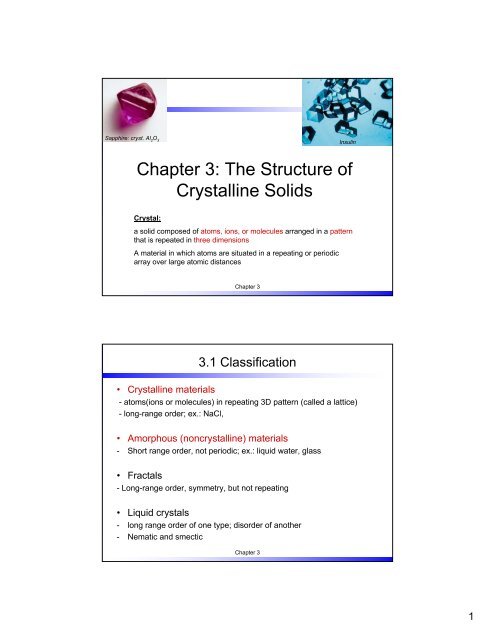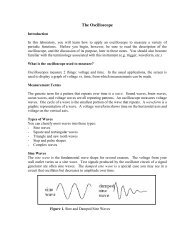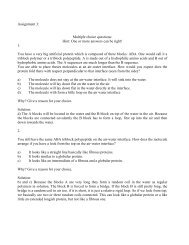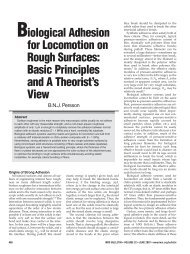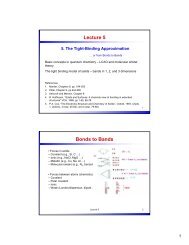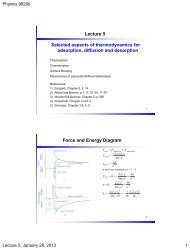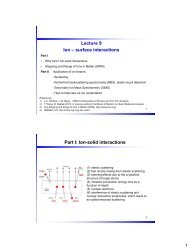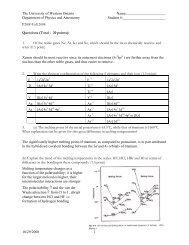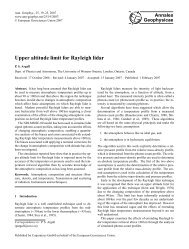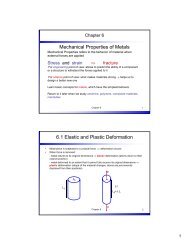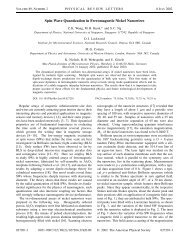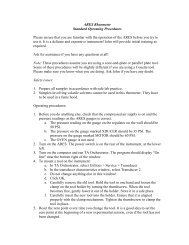Chapter 3: The Structure of Crystalline Solids
Chapter 3: The Structure of Crystalline Solids
Chapter 3: The Structure of Crystalline Solids
Create successful ePaper yourself
Turn your PDF publications into a flip-book with our unique Google optimized e-Paper software.
Sapphire: cryst. Al 2 O 3<br />
<strong>Chapter</strong> 3: <strong>The</strong> <strong>Structure</strong> <strong>of</strong><br />
<strong>Crystalline</strong> <strong>Solids</strong><br />
Crystal:<br />
a solid composed <strong>of</strong> atoms, ions, or molecules arranged in a pattern<br />
that is repeated in three dimensions<br />
A material in which atoms are situated in a repeating or periodic<br />
array over large atomic distances<br />
<strong>Chapter</strong> 3<br />
3.1 Classification<br />
<strong>Chapter</strong> 3<br />
Insulin<br />
• <strong>Crystalline</strong> materials<br />
- atoms(ions or molecules) in repeating 3D pattern (called a lattice)<br />
- long-range order; ex.: NaCl,<br />
• Amorphous (noncrystalline) materials<br />
- Short range order, not periodic; ex.: liquid water, glass<br />
• Fractals<br />
- Long-range order, symmetry, but not repeating<br />
• Liquid crystals<br />
- long range order <strong>of</strong> one type; disorder <strong>of</strong> another<br />
- Nematic and smectic<br />
1
- X<br />
Consider perfect ideal solid<br />
a2 O a1 + Y<br />
l<br />
Translational Symmetry<br />
<strong>The</strong> translational group represented by<br />
space lattice or Bravais net<br />
<strong>Chapter</strong> 3<br />
Lattice sites defined by:<br />
l = l 1 a 1 + l 2 a 2 + l 3 a 3<br />
<strong>The</strong> actual definition <strong>of</strong> a unit cell<br />
is to some extent arbitrary<br />
Space lattice<br />
<strong>Chapter</strong> 3<br />
NB: atoms do not necessarily<br />
coincide with space lattice<br />
Positions <strong>of</strong> atoms in crystals can be defined by referring the atoms to<br />
the point <strong>of</strong> intersection with 3D coordinate system<br />
+ Z<br />
000<br />
- Z<br />
- Y<br />
+ X<br />
Such network is called space or crystal lattice<br />
In ideal crystal the grouping <strong>of</strong> lattice points about<br />
any given point are identical with the grouping<br />
about any other lattice point in the crystal lattice<br />
2
α<br />
(0, 0, 0)<br />
b<br />
Unit cell<br />
a<br />
<strong>Chapter</strong> 3<br />
a = a<br />
c <strong>The</strong> size and shape <strong>of</strong><br />
the unit cell can be<br />
γ<br />
β<br />
described by three lattice<br />
vectors: a, b, c<br />
or the axial lengths a, b,<br />
and c and interaxial<br />
angles α, β, γ<br />
NB!!!: atoms do not necessarily coincide with lattice points<br />
How to choose unit cell?<br />
Unit cell: a convenient repeating unit <strong>of</strong> a crystal lattice; the axial lengths and<br />
axial angles are the lattice constants <strong>of</strong> the unit cell<br />
Wigner –<br />
Seitz cell<br />
<strong>Chapter</strong> 3<br />
Larger than<br />
needed<br />
Wigner – Seitz Cell : place the symmetry centre in<br />
the centre <strong>of</strong> the cell; draw the perpendicular<br />
bisector planes <strong>of</strong> the translation vectors from the<br />
chosen centre to the nearest equivalent lattice site<br />
3
symmetry<br />
Crystal systems (7)<br />
crystallographic point group – set <strong>of</strong> symmetry operations, (ex.: rotations or<br />
reflections), that leave a point fixed while moving each atom <strong>of</strong> the crystal to the position<br />
<strong>of</strong> an atom <strong>of</strong> the same kind<br />
<strong>Chapter</strong> 3<br />
14 Bravais Lattices<br />
<strong>Chapter</strong> 3<br />
4
Lowest in symmetry #1:<br />
230 lattices or spacegroups<br />
<strong>Chapter</strong> 3<br />
a ≠ b ≠ c; α ≠ β ≠ γ ≠ 90 o<br />
Even higher symmetry structure<br />
<strong>Chapter</strong> 3<br />
5
Metallic crystal structures (will talk about metal oxides later)<br />
• >90% <strong>of</strong> elemental metals crystallize upon solidification into 3 densely<br />
packed crystal structures:<br />
Body-centered cubic<br />
(bcc)<br />
ex.: Fe, W, Cr<br />
Face-centered cubic<br />
(fcc)<br />
ex.: Cu, Ag, Au<br />
<strong>Chapter</strong> 3<br />
Important to know:<br />
• Distance between atoms (d)<br />
- in terms <strong>of</strong> a<br />
• Number <strong>of</strong> atoms in the unit cell<br />
- each corner atoms shared by 8 cells: 1/8<br />
- each face atom shared by 2 cells: ½<br />
- each edge atom shared by 4 cells: 1/4<br />
• Coordination number<br />
<strong>Chapter</strong> 3<br />
Hexagonal closepacked<br />
(hcp)<br />
ex.: Zr, Ti, Zn<br />
- Number <strong>of</strong> nearest neighbours (n.n.); for metals all equivalent<br />
• Atomic Packing Factor (APF)<br />
APF = Volume <strong>of</strong> atoms in unit cell / Volume <strong>of</strong> unit cell (a 3 )<br />
6
Coordination number<br />
<strong>The</strong> number <strong>of</strong> atoms that surround a central atom in a solid is<br />
called coordination number<br />
C.N. = 3<br />
Corners<br />
<strong>of</strong> triangle<br />
C.N. = 6<br />
Corners<br />
<strong>of</strong> octahedron<br />
C.N. = 4<br />
Corners<br />
<strong>of</strong> tetrahedron<br />
C.N. = 8<br />
Corners<br />
<strong>of</strong> cube<br />
<strong>Chapter</strong> 3<br />
Body-Centered Cubic (bcc)<br />
Distance between atoms:<br />
Atoms/cell:<br />
Coordination number:<br />
Atomic Packing Factor (APF):<br />
a<br />
<strong>Chapter</strong> 3<br />
7
Face-Centered Cubic (fcc)<br />
Distance between atoms:<br />
Atoms/cell:<br />
Coordination number:<br />
Atomic Packing Factor (APF):<br />
<strong>Chapter</strong> 3<br />
Hexagonal close-packed (hcp)<br />
Distance between atoms: a and c<br />
Atoms/cell:<br />
Coordination number:<br />
Atomic Packing Factor (APF):<br />
<strong>Chapter</strong> 3<br />
8
- Y<br />
Density calculations<br />
• Calculate theoretical density <strong>of</strong> gold (Au), if the molar density is<br />
given: w = 0.1970 kg/mol; and a(Au)=0.408nm<br />
<strong>Chapter</strong> 3<br />
3.4 Atom coordinates in the cubic unit cell<br />
bcc<br />
+ X<br />
a<br />
000<br />
+ Z<br />
- Z<br />
<strong>Chapter</strong> 3<br />
- X<br />
+ Y<br />
(0, 0, 0)<br />
(1, 0, 0)<br />
(0, 1, 0)<br />
(0, 0, 1)<br />
(1, 1, 1)<br />
(1, 1, 0)<br />
(1, 0, 1)<br />
(0, 1, 1)<br />
(½, ½, ½)<br />
9
8 Cu 6 Cu<br />
(0, 0, 0) (½, ½, 0)<br />
(1, 0, 0) (0, ½, ½)<br />
(0, 1, 0) (½, 0, ½)<br />
(0, 0, 1) (½, ½, 1)<br />
(1, 1, 1) (1, ½, ½)<br />
(1, 1, 0) (½, 0, ½)<br />
(1, 0, 1)<br />
(0, 1, 1)<br />
Face-Centered Cubic (fcc)<br />
<strong>Chapter</strong> 3<br />
Sodium Chloride (NaCl)<br />
<strong>Chapter</strong> 3<br />
10
-Y<br />
Strontium titanate (Sr x Ti y O z )<br />
Ti O<br />
<strong>Chapter</strong> 3<br />
<strong>Chapter</strong> 3<br />
Sr<br />
3.5 Directions in cubic unit cell<br />
<strong>The</strong> crystallographic direction indices [u, v, w] - the vectors <strong>of</strong> the<br />
direction resolved along each <strong>of</strong> the coordinate axes and reduced to<br />
the smallest integers<br />
-2<br />
+ X<br />
2<br />
-1<br />
1<br />
000<br />
+ Z<br />
- Z<br />
1 2<br />
- X<br />
+ Y<br />
[2, 0, 0]<br />
=<br />
[1, 0, 0]<br />
11
Examples:<br />
<strong>Chapter</strong> 3<br />
Crystallographically equivalent<br />
• Parallel direction vectors have the same direction indices:<br />
ex.: determine the direction indices <strong>of</strong> the cubic direction shown<br />
• Directions are crystallographically equivalent if the atom<br />
spacing along each directions are the same<br />
ex.: [100], [010], [001], [-100], [0-10], [00-1] = <br />
<strong>Chapter</strong> 3<br />
12
3.6 Miller indices for crystallographic planes in<br />
cubic unit cells<br />
• Miller indices <strong>of</strong> a crystal plane are the reciprocals <strong>of</strong> the fractional<br />
intercepts that the plane makes with the crystallographic x, y, and z<br />
axes<br />
Most important crystallographic planes: (100), (110), (111)<br />
(100)<br />
intercepts:<br />
1, ∞, ∞<br />
<strong>Chapter</strong> 3<br />
Atomic Packing in Different Planes<br />
• bcc (100) (110) (111)<br />
• fcc (100) (110) (111)<br />
<strong>Chapter</strong> 3<br />
13
fcc crystallographic planes<br />
Cu (100)<br />
<strong>Chapter</strong> 3<br />
fcc crystallographic planes<br />
Cu (110)<br />
Anisotropy <strong>of</strong> properties in two directions<br />
<strong>Chapter</strong> 3<br />
14
3 fold symmetry<br />
fcc crystallographic planes<br />
Cu (111)<br />
<strong>Chapter</strong> 3<br />
STM (Scanning tunneling microscopy)<br />
Cu (100) Cu (111)<br />
Atomically resolved STM <strong>of</strong> Cu(100)<br />
<strong>Chapter</strong> 3<br />
Custom Low Temperature UHV STM<br />
image <strong>of</strong> atomic resolution pattern on<br />
Cu(111). Image taken at 4.2K.<br />
15
• Single plane (h k l)<br />
Crystallographic planes<br />
• Notation: planes <strong>of</strong> a family {h k l}<br />
(100); (010); (001); … ⇒{100}<br />
• Only for cubic systems: the direction indices <strong>of</strong> a direction<br />
perpendicular to a crystal plane have the same Miller indices<br />
as a plane<br />
• Interplanar spacing d hkl :<br />
d hkl<br />
=<br />
h<br />
2<br />
a<br />
+ k<br />
2<br />
+ l<br />
2<br />
<strong>Chapter</strong> 3<br />
3.7 Planes in hexagonal crystals<br />
4 coordinate axes (a 1 , a 2 , a 3 , and c) <strong>of</strong> the HCP structure (instead <strong>of</strong> 3)<br />
Miller-Bravais indices - (h k i l) – based on 4 axes coordinate system<br />
<strong>Chapter</strong> 3<br />
a1 , a2 , and a3 are 120o apart: h k i<br />
c axis is 90o : l<br />
3 indices (rarely used):<br />
h + k = - I<br />
(h k i l) ⇒ (h k l)<br />
16
Basal planes;<br />
a1 = ∞; a2 = ∞; a3 = ∞; c = 1<br />
⇒ (0 0 0 1)<br />
- a 2<br />
-2<br />
+ a 1<br />
2<br />
Basal and Prizm Planes<br />
<strong>Chapter</strong> 3<br />
<strong>Chapter</strong> 3<br />
Prizm planes: ABCD<br />
a1 = +1; a2 = ∞; a3 = -1; c = ∞<br />
⇒ (1 0 -1 0)<br />
Directions in hexagonal crystals<br />
-1<br />
- a 3<br />
1<br />
000<br />
+ c<br />
- c<br />
+ a 3<br />
1 2<br />
- a 1<br />
+ a 2<br />
[u, v, t, w] or<br />
[u, v, w] u + v = -t<br />
17
Principle directions in hcp<br />
<strong>Chapter</strong> 3<br />
3.8 Comparison <strong>of</strong> crystal structures<br />
FCC and HCP metal crystal structures<br />
• (111) planes <strong>of</strong> fcc have the same arrangement as (0001) plane <strong>of</strong> hcp crystal<br />
• 3D structures are not identical: stacking has to be considered<br />
<strong>Chapter</strong> 3<br />
A<br />
B Bb<br />
void a<br />
void b<br />
18
FCC and HCP crystal structures<br />
void a<br />
A A<br />
B<br />
B<br />
C<br />
fcc<br />
B plane placed in a voids <strong>of</strong> plane A<br />
Next plane placed in a voids <strong>of</strong><br />
plane B, making a new C plane<br />
Stacking: ABCABC…<br />
<strong>Chapter</strong> 3<br />
<strong>Chapter</strong> 3<br />
void b<br />
hcp<br />
B plane placed in a voids <strong>of</strong> plane A<br />
Next plane placed in a voids <strong>of</strong> plane B,<br />
making a new A plane<br />
Stacking: ABAB…<br />
3.9 Volume, planar, and linear density unit cell calculations<br />
Volume density <strong>of</strong> a metal can be obtained by using the hard-sphere<br />
atomic model for the crystal structure unit cell<br />
mass / unit _ cell<br />
_ density _ <strong>of</strong> _ metal = ρ =<br />
volume / unit _ cell<br />
Volume v<br />
Q.: Copper has an fcc crystal structure and<br />
an atomic radius <strong>of</strong> 0.1278nm. Assuming<br />
the Cu atoms to be hard spheres that touch<br />
each other along the face diagonal <strong>of</strong> the<br />
fcc unit cell, calculate a theoretical value for<br />
the density <strong>of</strong> Cu in kg/m 3.<br />
19
3.10 Allotropy and polymorphism (=..?)<br />
Allotropy – the ability <strong>of</strong> element to exist in two or more<br />
crystalline structures<br />
Fe: bcc ⇒ fcc ⇒ bcc<br />
In case <strong>of</strong> compound it is called polymorphism<br />
Carbon allotropic forms: ?<br />
1. diamond<br />
2. graphite<br />
3. fullerene or buckyballs<br />
4. nanotubes or buckysheets<br />
<strong>Chapter</strong> 3<br />
Carbon and its allotropes<br />
Diamond<br />
• Cubic structure<br />
(0, 0, 0) (1/2, 1/2, 0) (1/4, 1/4, 1/4)<br />
• Covalently bonded sp 3 orbitals<br />
• Isotropic<br />
• Stiffest, hardest (?) and least<br />
compressible<br />
• High thermal conductivity<br />
• But… no electrical conductivity<br />
<strong>Chapter</strong> 3<br />
20
Graphite<br />
Graphite<br />
• hexagonal structure<br />
• covalently bonded sp 2 orbitals and<br />
weak secondary bonds between<br />
planes<br />
• anisotropic<br />
• High thermal and electrical conductivity<br />
(in plane)<br />
• Bad thermal and electrical conductivity<br />
(between plane, along c axis)<br />
<strong>Chapter</strong> 3<br />
Fullerenes (Buckyballs)<br />
Discovered in 1985 by Harry Kroto and Richard Smalley while<br />
blasting graphite with a laser (C 30 to C 100 )<br />
• 12 pentagons and 20 hexagons<br />
• crystallize in fcc structure<br />
• isotropic<br />
• bonding: covalent and van der Waals forces<br />
<strong>Chapter</strong> 3<br />
21
Carbon nanotubes<br />
• hexagonal<br />
• properties depend on the structure<br />
• more later…<br />
<strong>Chapter</strong> 3<br />
Carbon Nanotubes<br />
<strong>The</strong> structure can be specified by vector (n, m)<br />
which defines how the graphene sheet is rolled up<br />
A nanotube with the indices (6,3): the sheet is<br />
rolled up so that the atom (0,0) is superimposed<br />
on the one labeled (6,3)<br />
m = 0 for all zig-zag tubes, while n = m for all<br />
armchair tubes<br />
<strong>Chapter</strong> 3<br />
22
Summary<br />
• Unit cells, crystal systems and lattices<br />
• Atomic coordinates and number <strong>of</strong> atoms in the unit cell<br />
• Crystallographic directions and crystal planes<br />
• Coordination numbers<br />
• Finding distances between atoms and planes, and<br />
characteristic angles<br />
• In order to find all this parameters: X-ray diffraction,<br />
electron microscopy (later)<br />
<strong>Chapter</strong> 3<br />
Problems<br />
3.1. Molybdenum is bcc and has an atomic radius <strong>of</strong> 0.14nm. Calculate a value for its lattice constant a in<br />
nanometers.<br />
3.2. Figure below illustrates unit cell <strong>of</strong> diamond crystal structure.<br />
(a) How many carbon atoms are there per unit cell?<br />
(b) What is the coordination number for each carbon atoms? (C.N is the number <strong>of</strong> equidistant nearest<br />
neighbors to an atom in a crystal structure)<br />
3.3. Draw direction vectors in unit cubes for the following directions: (a) [111], (b) [1-1-1], (c) [-12-1]; (d) [-<br />
1-13]<br />
3.4. Define the Miller indices <strong>of</strong> the cubic crystal plane that intersects the following position coordinates:<br />
(a)1/2, 0, 1/2); (0, 0, 1); (1, 1, 1); (b) (0, 0, 1/2); (1, 0, 0); (1/2, 1/4, 0)<br />
3.5. Draw in unit cubes the crystal planes that have the following Miller indices:<br />
(a) (1-1-1); (b) (10-2), (c) (1-21), (d) (21-3)<br />
3.6 Allotropic phase change. Iron is observed to undergo a<br />
transformation from bcc to fcc cubic structure at 921 0 C. Assuming that<br />
in each case the atoms behave as hard spheres and that the size <strong>of</strong><br />
these spheres is not affected by the transformation, determine the<br />
percentage change in volume that occurs.<br />
<strong>Chapter</strong> 3<br />
23


